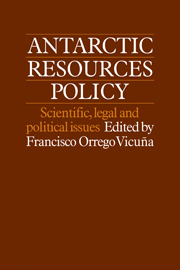Book contents
- Frontmatter
- Contents
- List of contributors
- 1 Antarctic resources policy: an introduction
- Part one The state of Antarctic knowledge and experience
- Part two The policy for the conservation of the living resources of Antarctica
- Part three The policy for the exploration and exploitation of the mineral resources of Antarctica
- Part four Issues on Antarctica and the law of the sea
- Part five The policy for Antarctic cooperation
- 20 Antarctica's role in international relations
- 21 Alternatives for cooperation and institutionalization in Antarctica: outlook for the 1990s
- 22 Resource development in polar regions: comments on technology
22 - Resource development in polar regions: comments on technology
Published online by Cambridge University Press: 06 July 2010
- Frontmatter
- Contents
- List of contributors
- 1 Antarctic resources policy: an introduction
- Part one The state of Antarctic knowledge and experience
- Part two The policy for the conservation of the living resources of Antarctica
- Part three The policy for the exploration and exploitation of the mineral resources of Antarctica
- Part four Issues on Antarctica and the law of the sea
- Part five The policy for Antarctic cooperation
- 20 Antarctica's role in international relations
- 21 Alternatives for cooperation and institutionalization in Antarctica: outlook for the 1990s
- 22 Resource development in polar regions: comments on technology
Summary
Introduction
An essential part of our discussions of policies for development and management of Antarctic resources is an appreciation of the technologies that will be used to discover the resources, to extract or harvest them and to take them to market. Animals, minerals or hydrocarbons in the Antarctic regions are not resources unless they can be obtained and delivered to market at a profit, otherwise they simply remain interesting animals, minerals and hydrocarbons. Strictly, the only Antarctic resources up until the present time have been whales and seals. The resources with which this book is mainly concerned, both living and non-renewable, are potential resources; and in considering them as such we are optimistically assuming that practical technologies are or will become available to turn these natural populations or deposits into products of commerce or national use. It will therefore be useful to reflect a little on some specific aspects of the problems and limitations of technological, economic and environmental aspects of resource development in polar regions.
The closest analogue to development and utilization of Antarctic resources, both the living resources harvested from cold and ice-covered waters and non-renewable resources from land or the sea-bed, is provided by the experience in Arctic regions. Sea mammals and birds have been hunted in ice-covered Arctic waters for about one thousand years by primitive methods and about one hundred years by industrial technologies; and for about three decades there has been steadily increasing attention to mineral resource development under the frozen land and ice-covered ocean, with consequent invention and testing of special technologies and management methods.
- Type
- Chapter
- Information
- Antarctic Resources PolicyScientific, Legal and Political Issues, pp. 297 - 316Publisher: Cambridge University PressPrint publication year: 1983

